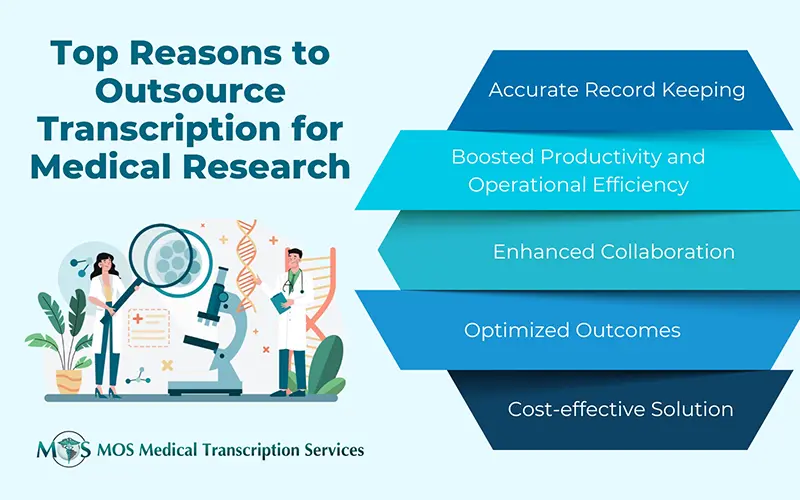Medical records are a combination of both self-reported patient information and a physician’s notes on the diagnosis, care and treatment given to the patient. When a patient visits a physician, the latter makes a diagnosis and dictates the patient’s medical condition via a digital recording machine. Many doctors use medical transcription services to transcribe these recordings into accurate medical records. Now EHR systems have been implemented in most provider facilities, and with HL7 interface transcriptionists can access the physician’s EHR and upload accurate medical records. Medical records should be documented in a timely and error-free manner.

Accuracy is a prime requirement for medical records. Only with accurate medical records, healthcare providers can develop an appropriate treatment plan and provide the necessary care. Errors in medical transcription can have grave financial, legal, and patient health impacts. In addition, important processes such as medical coding and billing, backup for potential audits, Meaningful Use attestation, all are dependent on the integrity of medical records. For good quality transcription, good quality audio is indispensable.
Tips for Achieving Excellent Quality Medical Transcripts
Here are some tips to ensure good quality audio and other requirements needed to achieve excellent quality medical transcripts.
- Speak clearly: Talk in a normal tone and depending on the microphone used, the recorder should be about ¾” from your mouth in an upright position. This helps the sound to go over the microphone and not directly into it. If you are using a smartphone or tablet as your recording device, ensure that the mics are not covered by your hand.
- Avoid a noisy environment: Choose a secure and quiet location for better results. Avoid areas that have background noises and cause distraction. Avoid telephone rings, music, vacuums, and beepers that can distract dictation and compromise quality.
- Be careful with difficult words: Medical terminology is complex, and new words are being added frequently. Then there are similar-sounding words that create confusion or lead to spelling mistakes. Be extra careful when using such words. Ideally, medical transcriptionists should use references resources like Stedman’s Medical Dictionary for double checking. They should never try to guess a word as it can lead to misinterpretation. If the words are not clear, then the best practice is to leave a blank space in the transcript till the term is clarified. Any doubts related to numerical description or units of measure should also be cleared.
- Be familiar with your device: Know how to use your recording system and basic functions such as Record, Pause, Play, Insert, Overwrite, Send etc. Make sure that the device is powered on. Give it a moment before you start speaking.
- Begin with complete and accurate demographics: Patients should be unambiguously identified and all their data should be available at the time of dictation. Begin dictation by mentioning their record number, appropriate dates and the report type. This will avoid confusion and documentation of wrong patients.
- Medical transcriptionists should have the updated list of names: MTs should have a complete list of all names, including dictating authors, and referral doctors. If you are using an electronic signature, make sure that you provide the medical transcription company, ahead of time, with the appropriate permission in writing and a copy of your handwritten signature if necessary.
- Send only encrypted files: Heavy penalties are imposed on data breaches. HIPAA compliance is very important and patient privacy must be safeguarded at all costs. All files must be encrypted for transmission to the transcription provider. Follow your facility’s and the medical transcription company’s protocol for sending and receiving files. For long recordings, the medical transcription company may provide proprietary software. Do not use emails to transfer files because they may not provide the required safety.
- Quality Assurance is a must: Quality should not be compromised as it will risk patient safety and quality of patient care. Make sure that the medical transcription company you partner with follows reliable QA standards. Learn about their QA measures and what guarantees they offer.
- Give timely feedback to the MTs: When working with a new MT, this is important. It will help improve the quality of the transcript. Ensure that the MTs are well qualified to successfully understand various accents and ESL dictators. Consider giving a sample dictation as a test when making a selection.
Accurate medical reports are essential for any hospital, clinic or healthcare unit and outsourcing medical transcription tasks is a practical solution to ensure that. The above-mentioned tips can help ensure more clarity in the transcripts. Apart from generating clear audio, to achieve excellent quality transcription maximum attention should be given to workflow details such as providing complete and correct information, alerting the transcriptionist to any special instructions, clear identification of STAT or amended reports, and secure file transmission.


